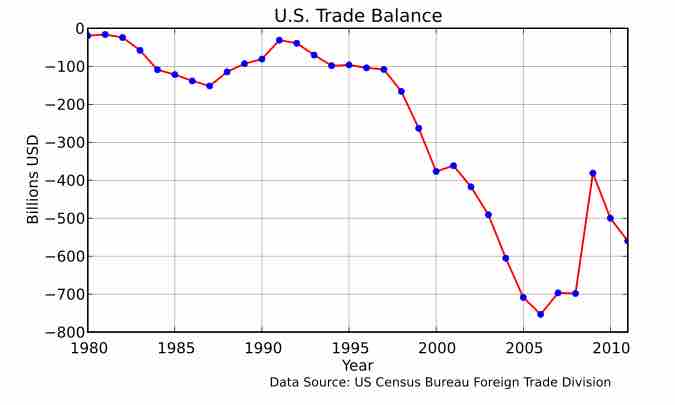Balance of Trade
The balance of trade (or net exports, sometimes symbolized as NX) is the difference between the monetary value of exports and imports of output in an economy over a certain period. It is the relationship between a nation's imports and exports. A positive balance is known as a "trade surplus," if it consists of exporting more than is imported; a negative balance is referred to as a "trade deficit" or, informally, a "trade gap." The balance of trade is sometimes divided into a goods and a services balance. The trade balance is identical to the difference between a country's output and its domestic demand (the difference between what goods a country produces and how many goods it buys from abroad; this does not include money re-spent on foreign stock, nor does it factor in the concept of importing goods to produce for the domestic market).
Measuring the balance of trade can be problematic because of problems with recording and collecting data. As an illustration of this problem, when official data for all the world's countries are added up, exports exceed imports by almost 1%; it appears the world is running a positive balance of trade with itself. This cannot be true, because all transactions involve an equal credit or debit in the account of each nation. The discrepancy is widely believed to be explained by transactions intended to launder money or evade taxes, smuggling and other visibility problems. However, especially for developed countries, accuracy is likely. Factors that can affect the balance of trade include:
- The cost of production (land, labor, capital, taxes, incentives, etc.) in the exporting economy vis-à-vis those in the importing economy
- The cost and availability of raw materials, intermediate goods and other inputs
- Exchange rate movements
- Multilateral, bilateral and unilateral taxes, or restrictions on trade
- Non-tariff barriers, such as environmental, health, or safety standards
- The availability of adequate foreign exchange with which to pay for imports
- Prices of goods manufactured at home (influenced by the responsiveness of supply)
In addition, the trade balance is likely to differ across the business cycle. In export-led growth (such as oil and early industrial goods), the balance of trade will improve during an economic expansion. However, with domestic demand-led growth (as in the United States and Australia), the trade balance will worsen at the same stage in the business cycle as these economies will import additional raw materials and finished goods.

US Trade Balance
U.S. trade balance from 1980-2010